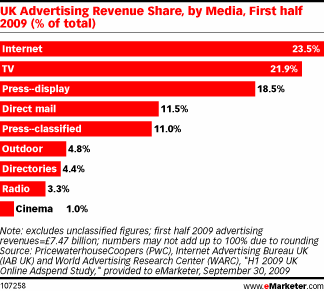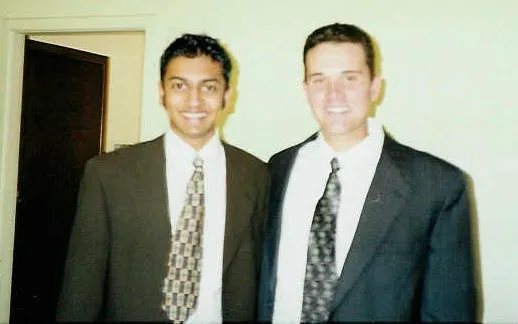UK shows us the future of advertising. Progress or sign that we’re unwilling to learn from history?
This is big news folks. The UK is now apparently spending more money as a nation on online advertising than they do on TV advertising. This article and the chart here say its so.
 Ah, so this is progress isn’t it? The world is getting smarter. The more we put our advertising dollars to work on the web vs. on the TV is a sure sign of progress, right? I mean, on the web, that’s where everything is moving. That’s where all the action is. TV is dead anyway. Right?
Ah, so this is progress isn’t it? The world is getting smarter. The more we put our advertising dollars to work on the web vs. on the TV is a sure sign of progress, right? I mean, on the web, that’s where everything is moving. That’s where all the action is. TV is dead anyway. Right?
Unfortunately, this is a sure sign that we (advertisers, companies, agencies…we) refuse to learn from history. Now I’m not suggesting that advertising on TV is the way to go. Everyone who doesn’t have a DVR soon will, and skipping TV commercials is a badge of honor in most households. We hone our commercial-skipping skills to see how closely we can stop the fast-forward to start right at the end of the commercial. You know you do it. I happen to be near professional at it.
Here’s the problem folks. Ads NEVER WORKED on the web. It’s actually worse than the fast-forward mentality of TV viewers. On the web, we have banner blindness. We don’t even see them.
I recently attended the Social Ad Summit in NY. Really smart folks, great conversations, some of the leading digital companies there, including Pandora, Wikipedia, RockYou and Zynga. But even in the midst of all these smart folks, the conversation still revolved around how we’re going to advertise to people on the web and steal more budget from those offline folks. The more pages, the more views, the more we can sell to the advertisers, the more publishers can make, etc. There was very little discussion about alternative ways to get around advertising (outside of the gaming guys that do seem to get it).
What I’m getting to here is that we’re headed down a dead-end path. We’re spending WAY too much time trying to figure out how to move our advertising budgets from offline to online and almost no time on how to find new ways to monetize online properties and find ways to engage in relevant ways with consumers. People don’t want to be advertised to on the web. They don’t want to be interrupted. Unless they’re specifically in the market for your product, which is why search is the only viable form of online advertising today.
I also happen to think this is why Facebook is holding off on just blasting their site with banner ads. They’d make a fortune immediately, but pretty soon we’d all leave the way we did with MySpace. It’s not a sustainable method of monetizing the web. I’m looking for a better way, not just an online way of doing what we know doesn’t work offline.



Jeff, before you go too far down this path, I think there may be a few points to consider. The most important clarification is to define what is included in “internet advertising” for this report. Based on the sister eMarketer chart to this one, I believe they classify FOUR components into this category: Paid Search, Classifieds, Display and Solus E-mail. This further breaks down to about 60% going to Paid Search, ~20% to Classifieds, ~17% to display and finally ~3% to Solus email. Furthermore, I believe paid search has driven the UK digital ad spending growth, just as it has in the US.
So, I agree that best laid advertising programs aim to facilitate and be a part of a conversation or experience rather than interrupting it. But…based on the #s, UK growth is from HAND RAISERS. This is the best form of growth. It is a testament that search can be a winner for al sorts of advertisers, not just acquisition models. The US is on a similar growth trajectory, and I don't see this as a bad thing.
As for what I believe you were assuming this growth was about, display ads, I'd also point out that we have seen a surge in more relevant, content enhancing rich media ads that are supporting the content within which it is surrounded, rather than just being a distraction. Marketers are in fact getting more savvy about the benefits of adding value via rich display ad experiences in the place where consumers are consuming information…rather than demanding the consumer to always come to the advertiser site.
Damn @karnacrawford, you set me straight on this. I assumed it was literally online ads. Can't disagree with anything you wrote (though I was hoping too!).
“I'd also point out that we have seen a surge in more relevant, content enhancing rich media ads that are supporting the content within which it is surrounded, rather than just being a distraction.”
Nice comment, Karna. With regard to the above quote, can you give us an example of a content enhancing rich media ad?
Personally, I've never come across a content enhancing display ad. Anything that is not what I”m doing is a big annoyance. I don't click anything or pay attention to any ads. This seems to be the case for my age-group (I'm 22).
When it comes to online ad content that adds value, videos seem to be the only one that sticks out (like the Cadbury Gorilla drumming video).
Of course, now I don't spend near as much time on YouTube (which may be a good thing) due to it being filled with ads….
“I'd also point out that we have seen a surge in more relevant, content enhancing rich media ads that are supporting the content within which it is surrounded, rather than just being a distraction.”
Nice comment, Karna. With regard to the above quote, can you give us an example of a content enhancing rich media ad?
Personally, I've never come across a content enhancing display ad. Anything that is not what I”m doing is a big annoyance. I don't click anything or pay attention to any ads. This seems to be the case for my age-group (I'm 22).
When it comes to online ad content that adds value, videos seem to be the only one that sticks out (like the Cadbury Gorilla drumming video).
Of course, now I don't spend near as much time on YouTube (which may be a good thing) due to it being filled with ads….
Great question. I'd point to a few things I've seen created by Coke, Verizon Wireless, and a few others. I created a rich ad for Coke to support Healthy Active Living in association with Olympics. Created a media plan with iVillage that had a content program rooted in helping moms find a way to inject healthy active living into their own lives and that of their family. This included aggregating content from many different articles into one co-branded section of the iVillage site. Then I negotiated to own all advertising space on that page, and used the space to push a rich media ad that had different tools related to measuring and planning healthy active living related things.
One additionally add I will make is that we have a number of technology vendors out there pushing dynamic banner ads, including the ability to make a dynamic video ad. In this instance, you can marry data you know about the consumer (behavioral or consumer data), couple it with some business rules related to the CONTENT within which the ad will be served in your media plan, and it can dynamically serve up the best combination of which video footage, creative graphics and copy will show up uniquely for each person (or segment). This is a fragmented space, and I'm driving to spark an industry movement to get far more aggressive with delivering relevant ads this way.
Jeff, before you go too far down this path, I think there may be a few points to consider. The most important clarification is to define what is included in “internet advertising” for this report. Based on the sister eMarketer chart to this one, I believe they classify FOUR components into this category: Paid Search, Classifieds, Display and Solus E-mail. This further breaks down to about 60% going to Paid Search, ~20% to Classifieds, ~17% to display and finally ~3% to Solus email. Furthermore, I believe paid search has driven the UK digital ad spending growth, just as it has in the US.
So, I agree that best laid advertising programs aim to facilitate and be a part of a conversation or experience rather than interrupting it. But…based on the #s, UK growth is from HAND RAISERS. This is the best form of growth. It is a testament that search can be a winner for al sorts of advertisers, not just acquisition models. The US is on a similar growth trajectory, and I don't see this as a bad thing.
As for what I believe you were assuming this growth was about, display ads, I'd also point out that we have seen a surge in more relevant, content enhancing rich media ads that are supporting the content within which it is surrounded, rather than just being a distraction. Marketers are in fact getting more savvy about the benefits of adding value via rich display ad experiences in the place where consumers are consuming information…rather than demanding the consumer to always come to the advertiser site.
Damn @karnacrawford, you set me straight on this. I assumed it was literally online ads. Can't disagree with anything you wrote (though I was hoping too!).
“I'd also point out that we have seen a surge in more relevant, content enhancing rich media ads that are supporting the content within which it is surrounded, rather than just being a distraction.”
Nice comment, Karna. With regard to the above quote, can you give us an example of a content enhancing rich media ad?
Personally, I've never come across a content enhancing display ad. Anything that is not what I”m doing is a big annoyance. I don't click anything or pay attention to any ads. This seems to be the case for my age-group (I'm 22).
When it comes to online ad content that adds value, videos seem to be the only one that sticks out (like the Cadbury Gorilla drumming video).
Of course, now I don't spend near as much time on YouTube (which may be a good thing) due to it being filled with ads….
Great question. I'd point to a few things I've seen created by Coke, Verizon Wireless, and a few others. I created a rich ad for Coke to support Healthy Active Living in association with Olympics. Created a media plan with iVillage that had a content program rooted in helping moms find a way to inject healthy active living into their own lives and that of their family. This included aggregating content from many different articles into one co-branded section of the iVillage site. Then I negotiated to own all advertising space on that page, and used the space to push a rich media ad that had different tools related to measuring and planning healthy active living related things.
One additionally add I will make is that we have a number of technology vendors out there pushing dynamic banner ads, including the ability to make a dynamic video ad. In this instance, you can marry data you know about the consumer (behavioral or consumer data), couple it with some business rules related to the CONTENT within which the ad will be served in your media plan, and it can dynamically serve up the best combination of which video footage, creative graphics and copy will show up uniquely for each person (or segment). This is a fragmented space, and I'm driving to spark an industry movement to get far more aggressive with delivering relevant ads this way.